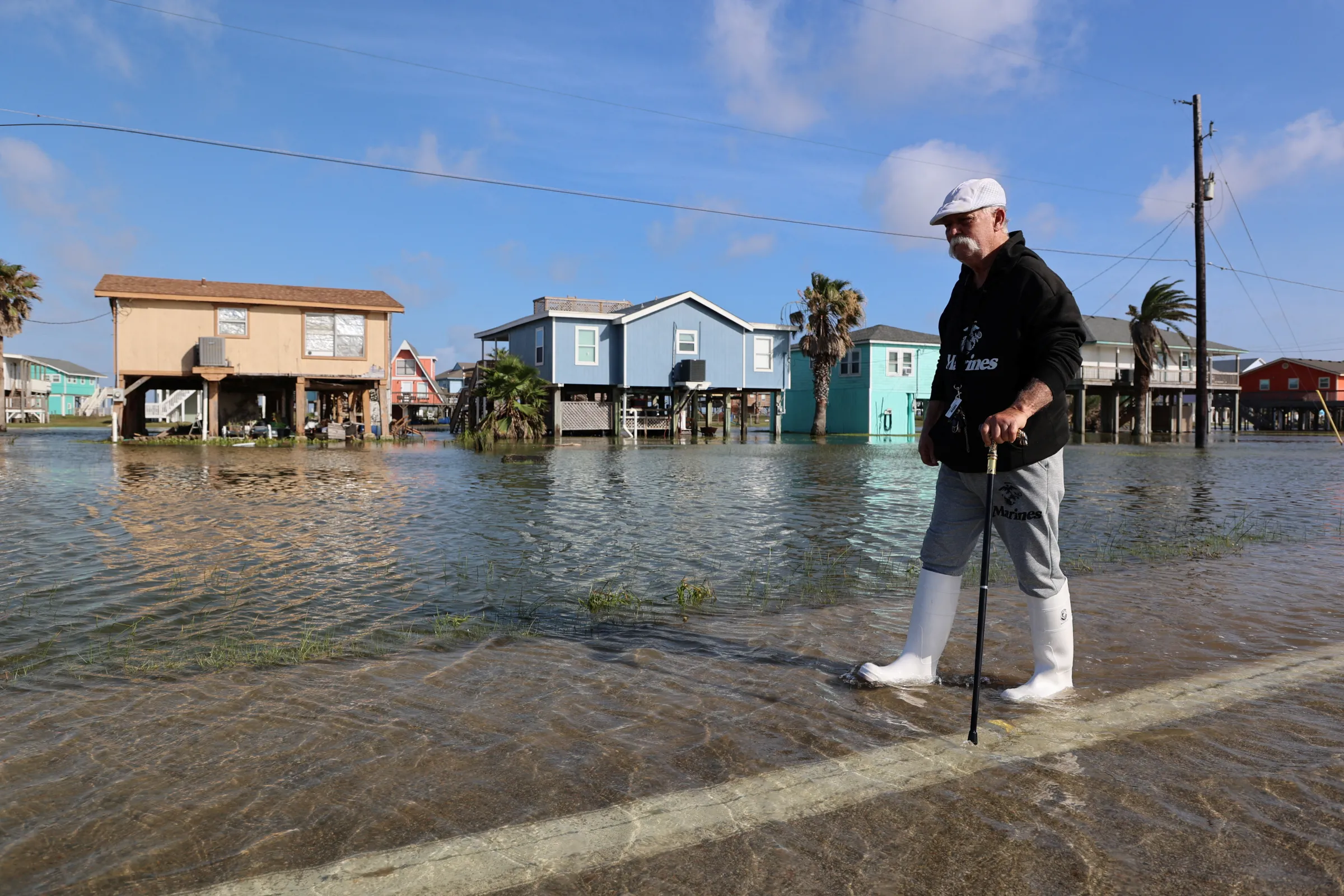How, and where climate change will lower U.S. home values

A resident walks through floodwaters outside his home in Surfside Beach, Texas, U.S. June 20, 2024 . REUTERS/Evan Garcia
What’s the context?
U.S. homeowners face higher home insurance costs and decreasing property values in climate-risky areas
- Climate may put $1.47 trillion in real estate value at risk
- Environmental, insurance concerns could affect migration: study
- Insurance woes plague California after LA area wildfires
RICHMOND, Virginia- Climate change is quickly upending the home insurance market in the United States as well as globally and is projected to bring sweeping change in U.S. real estate values over the next 30 years, new research shows.
Although Americans still flock to climate-risky areas, the longtime trend could start to change, according to a novel report from First Street Foundation, a climate risk mapping group.
Even counties in New Jersey, along the U.S. East Coast, are among the regions most at risk of "climate abandonment," the report found, illustrating how regions far from wildfire-ravaged California and the hurricane-prone Southeast are not immune from escalating impacts.
There are competing factors as well. Local governments in climate-vulnerable areas face eroding tax bases just as they need to ramp up adaptation efforts and regions taking on climate migrants must manage growth while maintaining affordability, the report noted.
Climate change is contributing to a net aggregate potential $1.23 trillion in value losses for U.S. residential properties by 2055, the report found.
"The resulting shifts in property values and population are not just reshaping individual housing markets but reconfiguring the economic geography of the entire nation," it said.
Here's how climate change could upend real estate, particularly in the most popular destinations in the United States:
How will climate change affect property values?
By 2055, more than 70,000 neighbourhoods, or 84% of U.S. Census tracts, may experience some form of negative property value impacts from climate risk to the tune of $1.47 trillion in losses relative to current value, according to the First Street study.
A subset of "climate-resilient" neighbourhoods stand to gain roughly $244 billion in value from factors like favourable migration and insurance pressures, translating to a net aggregate $1.23 trillion in potential value losses by 2055.
Key to understanding the projections are increased environmental hazards and rising insurance costs, said Jeremy Porter, head of climate implications research at First Street.
"There is this quality-of-life metric that's being directly impacted by climate exposure, and then the insurance costs are also increasing as a response to that exposure," Porter said at an online briefing.
What areas are likely to see the most pronounced effects?
Counties in Florida like Broward and Duval, which have been battered by recent hurricanes, are expected to be hit with some of the biggest drops in overall property value – even though the model's projections showed people continuing to move to the state.
"The insurance impacts in this case are what are driving the total property value impacts," Porter said.
While some experts say the escalating scale of the climate crisis means there are essentially no more "climate havens" safe from impacts, parts of the Midwest are projected to see long-term growth in both property values and economic metrics.
Places like Dane County in Wisconsin were projected to see long-term positive impacts as more people migrate there and contribute to the local economies with comparatively fewer negative climate effects.

Remains of Fort Myers Beach Town Hall are pictured in Fort Myers Beach, Florida, USA, May 24, 2023. Thomson Reuters Foundation/Amie Santavicca
Remains of Fort Myers Beach Town Hall are pictured in Fort Myers Beach, Florida, USA, May 24, 2023. Thomson Reuters Foundation/Amie Santavicca
Do homeowners factor climate into their purchasing and moving patterns?
Americans, driven by lower costs and proximity to amenities like coastal waters in some cases, have historically flocked to climate-risky areas like Florida and California.
But there could be a slowing down of this trend, according to a November 2024 report from Redfin, a real estate tracking and research company.
It found that homes with low natural disaster risks were rising in value faster than homes with high risk for the first time in more than 10 years.
"The dynamics between climate risk, the insurance market, and consumer perceptions suggest a future where climate considerations become increasingly central to property valuation, with implications for local economic development," the First Street report said.
How does insurance factor into all this?
Climate change is fuelling hotter, drier conditions that lay the groundwork for more intense and frequent natural disasters like hurricanes and wildfires.
Insurers, in turn, have started curbing their offerings for home insurance in disaster-prone areas like California and Florida, where they may not be profitable while paying out claims associated with an increasing number of major disasters.
In the aftermath of the devastating Los Angeles area wildfires in January, State Farm, California's largest private insurer, this month urged the state's insurance regulator to approve an emergency hike in rates to help offset the hefty payouts the company is making after Los Angeles wildfires.
State Farm officials wrote to California Insurance Commissioner Ricardo Lara that the fires "will collectively be the costliest in the history of the company."
People who live in special flood hazard areas are also mandated to purchase flood insurance in addition to standard home insurance, adding yet another cost to homeownership for people living in climate-risky areas.
"It's this duality of increasing prices that you see across the board for certain properties or certain commercial institutions or businesses," Matthew Eby, founder and CEO of First Street, said at the briefing.
(Reporting by David Sherfinski; Editing by Anastasia Moloney and Ellen Wulfhorst.)
Context is powered by the Thomson Reuters Foundation Newsroom.
Our Standards: Thomson Reuters Trust Principles
Tags
- Extreme weather
- Adaptation
- Climate policy
- Loss and damage
- Economic inclusion
- Climate solutions














